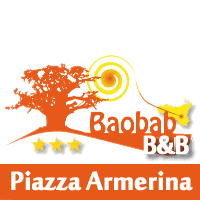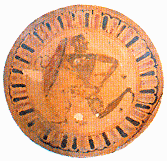Home - In and around
HYBLAEAN REGIONAL ARCHAEOLOGICAL MUSEUM
Hyblaean Regional Archaeological Museum
The museum is situated behind Via Roma, close to the northern side of the Ponte Nuovo (Pennavaria).
The museum is housed on the first floor of the Mediterraneo Palace, built in the 50s in an expanding area of the city. Between 1955 and 1960 it housed the Antiquarium which represented the first core of the museum.
At the end of the 60s the museum was completely restored and got its actual arrangement.
The museum illustrates the archaelogy and the old history of the territory of Ragusa province, from the Neolithic to the late ancient times.
Evidences of human life during the Neolithic have been found close to Acate, in Contrada Pirrone.
To the Bronze Age a close net of hut villages can be attributed, built on hills as well as on plains, among rivers and on the coast. Among these villages we mention Castiglione which was occupied again by natives in the protoarchaic period. Particularly important are the settlements of Monte Raci and Branco Grande.
In the archaic Greek period, the most important settlement of the Hyblaean territory is Camarina, a colony established by Siracusa. This town played a very important role in the acculturation process of the local settlements which came in contact with it, such as Monte Casasia and Castiglione.
The settlement of Scornavacche (Chiaramonte Gulfi), a village of coroplasti (manufacturer of terracottas), is dated back to the Hellenistic period. The settlement of Caucana, an important harbour where Christian evidences have been found, is dated to the late ancient times.
The collections. The finds of the first excavations made in the Greek necropolis of Rito (Ragusa) and in the Hellenistic settlement of Scornavacche (Chiaramonte Gulfi) were initially exhibited in the Antiquarium of Ragusa. Later, when the museum was enlarged in the 70s, were added the finds of the excavations made in Camarina, in the Siculian necropolis of Castiglione and in the late ancient period settlement of Caucana. The museum also exhibits the finds coming from the collections made in the first decades of the 20th c. within the territory of Ragusa province and bought by the Sicilian Region, such as the collections of Melfi di Chiaramonte, Pacetto, La Rocca and Pace.
The arrangement is organized by chronological criteria and topographical areas and is characterized by faithful reconstruction of small parts of excavations. These rooms (necropoli, brick-kilns and mosaic floorings) explain visitors how the exhibited objects were used.
The museum is articulated in six sections.
Section 1 The prehistoric sites
Section 2 The Greeks in the province (Camarina)
Section 3 Ancient and classical Siculian settlements. Monte Casasia, Licodia Eubea, Castiglione, Hibla
Section 4 Hellenistic settlements. Scornavacche
Section 5 Late-Roman settlement. Kaukana
E. Faithful reconstruction: mosaics of the little church of S. Croce Camerina
Section 6 Collections and acquisitions
Address : Via Natalelli
Province : Ragusa City : Ragusa
Phone : 0932 622963 - fax 0932 622963
Opening hours : dalle ore 9,00 alle ore 13,00 e dalle 15,00 alle 19,00
Ticket full fare : Gratuito
(Source: website of the regional cultural heritage)
The museum is situated behind Via Roma, close to the northern side of the Ponte Nuovo (Pennavaria).
The museum is housed on the first floor of the Mediterraneo Palace, built in the 50s in an expanding area of the city. Between 1955 and 1960 it housed the Antiquarium which represented the first core of the museum.
At the end of the 60s the museum was completely restored and got its actual arrangement.
The museum illustrates the archaelogy and the old history of the territory of Ragusa province, from the Neolithic to the late ancient times.
Evidences of human life during the Neolithic have been found close to Acate, in Contrada Pirrone.
To the Bronze Age a close net of hut villages can be attributed, built on hills as well as on plains, among rivers and on the coast. Among these villages we mention Castiglione which was occupied again by natives in the protoarchaic period. Particularly important are the settlements of Monte Raci and Branco Grande.
In the archaic Greek period, the most important settlement of the Hyblaean territory is Camarina, a colony established by Siracusa. This town played a very important role in the acculturation process of the local settlements which came in contact with it, such as Monte Casasia and Castiglione.
The settlement of Scornavacche (Chiaramonte Gulfi), a village of coroplasti (manufacturer of terracottas), is dated back to the Hellenistic period. The settlement of Caucana, an important harbour where Christian evidences have been found, is dated to the late ancient times.
The collections. The finds of the first excavations made in the Greek necropolis of Rito (Ragusa) and in the Hellenistic settlement of Scornavacche (Chiaramonte Gulfi) were initially exhibited in the Antiquarium of Ragusa. Later, when the museum was enlarged in the 70s, were added the finds of the excavations made in Camarina, in the Siculian necropolis of Castiglione and in the late ancient period settlement of Caucana. The museum also exhibits the finds coming from the collections made in the first decades of the 20th c. within the territory of Ragusa province and bought by the Sicilian Region, such as the collections of Melfi di Chiaramonte, Pacetto, La Rocca and Pace.
The arrangement is organized by chronological criteria and topographical areas and is characterized by faithful reconstruction of small parts of excavations. These rooms (necropoli, brick-kilns and mosaic floorings) explain visitors how the exhibited objects were used.
The museum is articulated in six sections.
Section 1 The prehistoric sites
Section 2 The Greeks in the province (Camarina)
Section 3 Ancient and classical Siculian settlements. Monte Casasia, Licodia Eubea, Castiglione, Hibla
Section 4 Hellenistic settlements. Scornavacche
Section 5 Late-Roman settlement. Kaukana
E. Faithful reconstruction: mosaics of the little church of S. Croce Camerina
Section 6 Collections and acquisitions
Address : Via Natalelli
Province : Ragusa City : Ragusa
Phone : 0932 622963 - fax 0932 622963
Opening hours : dalle ore 9,00 alle ore 13,00 e dalle 15,00 alle 19,00
Ticket full fare : Gratuito
(Source: website of the regional cultural heritage)



